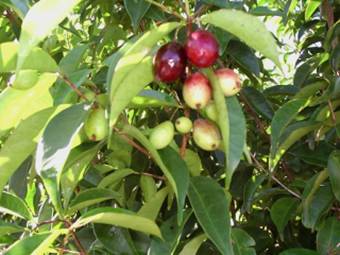EUGENIA
CANDOLLENA AND MYRCIARIA FLORIBUNDA
POPULAR
NAMES: Cambuí
roxo (E. candolleana) , Cambuí vermelho (M.
floribunda),
Rainforest Plum
MYRTACEAE

Cambuí
roxo (Eugenia candolleana)
INDIGENOUS
NAME: Cambuí
comes from the Tupi Guarani and means "tree of fine branches or twigs" and
in fact all the more
than 100 species of myrtaceas called Cambuí has delicate foliage.
Origin:
The Cambuí roxo is from
the Atlantic coast and Cambuí vermelho occurs in several forest formations
of South America and Brazil.
Characteristics:
The Cambuí roxo is a
shrub branched from
2 to
4 m
(7 to 13 feet)
tall,
with rounded, conical and dense crown, with up to
2 m
(7 feet) in diameter.
The foliage and young leaves are going to ferruginous yellow and then
become dark light green.
The bark is reddish brown in peeling color, a naked trunk smooth and
reddish. The leaves are simple, glossy (without hairs), opposite, with
petiole or stem of
5
to
8 mm
long, the texture is
leathery and smooth and the margin reflex apex down.
The flowers come in groups of more than 20 in beep stems (stem divided
into 2 classes each with one flower) from
1
to
2 cm
long, the axils of
the leaves in the terminal branches.
The Cambuí vermelho
is a sub-forest
tree that reaches
heights of 3
to
4
m
(10 to 13 feet),
with
sparse
branches and branches forming sparse canopies, the trunk is straight and
smooth shell peeling in the longitudinal direction, with red color and
opaque.
The leaves are simple, opposite and glossy (without hairs) with petiole
or stem of
3
to
4 mm in the
length.
The blade or leaf texture is like cardboard and measured
3
to
4 cm
long by
0.8 to
1.8 cm
wide and the flowers
come in groups of
3
to
5
in clusters (or
cluster type of summit with
multiparity condensed
flowers)
axillary (in the base or find the leaf with the branch).These
are tiny and contains 5 sepals and 5 white petals of
3 mm in the
length.
Planted in
the site of Frutas Raras:
The Cambuí roxo was
planted in September 2003
and bears fruit the
first time in 2005
and the Cambuí
vermelho was planted in September 2004 and not bear fruit yet.
Tips for
cultivation:
Fast
growing shrubs, which appreciate any soil with good natural fertility and
rapid drainage of rain water, is resistant to light frosts to -1°C (30°F).
The plant fruits
abundantly in full sun, more water should not miss in the flowering time and
the fruiting time.
Propagation: The
seeds are round, small in the case of Cambuí vermelho and Cambuí relatives
(lose their germinative power if dried) and germinate in
40 to
60 days, the seedlings should be formed on substrate of 50% of red soil,
30% organic matter and 20% of sand, has moderate growth, reach
30 cm (1 foot) in the
age of
8 months in the nursery.
The Cambuí roxo begins to produce in the age of 2 years after planting.
Planting:
I recommend to
plant in full sun in a space of 5 x
5 m
(17 x 17 feet)
for the Cambuí Roxo and
4 x
4 m
(13 x 13
feet)
for the
Cambuí Vermelho.
Best planting time is
October to November, to
water
10 l
of water
after planting and every 15 days if no rain.
The holes should be
50 cm
50 cm
in 3 dimensions and filled by 30% organic matter to
30 cm
of depth of the pit
mixed with
300 g
of limestone and
500 g
of wood ash.
Cultivating: The
plant grows fast and needs no special care, only the surface should be
covered by powder to close and eliminate any weed that can choke the plant.
Fertilize with 3kg of organic compost made from chicken manure and a
large volume of dry leaves or grass and work
30 grams
of NPK 10-10-10 in.
Distribute the nutrients to
5 cm into
the
surface
20 cm
from
the stem at the beginning of October.
Uses:
The fruit is consumed
in-kind and in the form of juices.
Flowering
in the site of Frutas Raras:
November to January.
Fruiting
in the site of Frutas Raras:
February to March for
Cambuí roxo.
LEARN MORE ABOUT THE CLASSIFICATION,
ORIGIN, HISTORY, STATEMENT OF PLAN, CULTURAL PRACTICES, MEDICINAL PROPERTIES
IN THE PORTUGUESE LANGUAGE
BUY THE BOOK
“COLECIONANDO FRUTAS”
Back to the
seedlist (English)
or
back to Myrtaceae (Portuguese)
